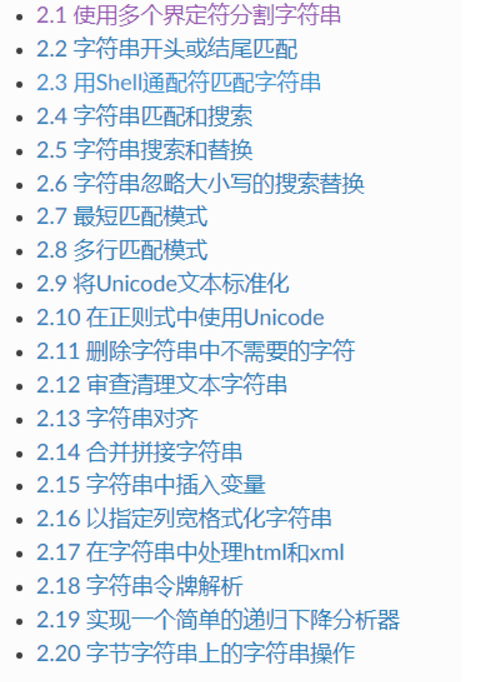 复杂数据类型-字符串
复杂数据类型-字符串
# 链接资料
2.1 使用多个界定符分割字符串 - python3-cookbook 3.0.0 文档 (opens new window)
# 1. 字符串的创建
将文本放在单引号、双引号和三引号之间
str1 = ' hello, fanison '
str1 = " hello, fanison "
str1 = """hello word"""
2
3
# 2 字符串的转义
原生字符串:使用r
str1 = r"hello, fanison"
# 3. 字符串的相关方法
详细:建议多看文档
Python 字符串方法 (opens new window)
| --- | --- |
注释:所有字符串方法都返回新值。它们不会更改原始字符串。
s.index(sub [,start [,end]]) 找到指定字符串sub首次出现的位置,找不到就报错
s.find(str,beg=0,end=len(string)) 找到字符串sub首次出现位置,与index不同是不报错而返回-1
s.upper() 将一个字符串转换为大写形式
s.lower() 将一个字符串转化为小写形式
s.join(t) 使用s作为分隔符连接序列t中的字符串 s.strip() 将s两边不显示的符号去掉之后返回(lstrip、rstrip)
s.split(t) 获取以字符t将s切割的列表
s.encode() 获取s的指定编码的bytes值
bytes.decode() 获取bytes的对应编码的字符串,在python2中使用decode函数
s.endswith(suffix,beg=0, end=len(string)) 检查中是否以suffix字符串结尾
x = "do you fuck me?"
print(x.index("y")) # 找不到就报错
print(x.find("z")) # 找不到就返回-1
print(x.upper())
print(x.lower())
print(x.join("-x"))
print(x.split(" "))
print(x.encode())
print(x.endswith("f")) # 判断结尾是不是以f
"""
3
-1
DO YOU FUCK ME?
do you fuck me?
-do you fuck me?x
['do', 'you', 'fuck', 'me?']
b'do you fuck me?'
False
"""
2
3
4
5
6
7
8
9
10
11
12
13
14
15
16
17
18
19
20
21
22
23
24
25
26
27
28
29
# 4. str() 和 repr() 的区别
str() 和 repr() 函数虽然都可以将数字转换成字符串,但它们之间是有区别的:
- str() 用于将数据转换成适合人类阅读的字符串形式。
- repr() 用于将数据转换成适合解释器阅读的字符串形式(Python 表达式的形式),适合在开发和调试阶段使用;如果没有等价的语法,则会发生 SyntaxError 异常。
# 5. p****ython 中的 Unicode****
如果要创建 Unicode 字符串,请在文本开头添加u或U字符。
#!/usr/bin/env python
# unicode.py
text = u'\\u041b\\u0435\\u0432 \\u041d\\u0438\\u043a\\u043e\\u043b\\u0430\\
\\u0435\\u0432\\u0438\\u0447 \\u0422\\u043e\\u043b\\u0441\\u0442\\u043e\\u0439: \\n\\
\\u0410\\u043d\\u043d\\u0430 \\u041a\\u0430\\u0440\\u0435\\u043d\\u0438\\u043d\\u0430'
print(text)
2
3
4
5
6
7
8
9
# 6. *字符串格式化输出*
字符串格式化是将各种值动态地放入字符串中。 可以使用%运算符或format()方法实现字符串格式化。
# 1. 格式化字符串字面值f
格式化字符串字面值 (opens new window)(简称为 f-字符串)在字符串前加前缀 f或 F,通过 {expression}表达式,把 Python 表达式的值添加到字符串内。
格式说明符是可选的,写在表达式后面,可以更好地控制格式化值的方式。下例将 pi 舍入到小数点后三位:
**import** **math>>>** print(f'The value of pi is approximately **{**math.pi**:**.3f**}**.')
The value of pi is approximately 3.142.
2
在 ':' 后传递整数,为该字段设置最小字符宽度,常用于列对齐:
>>> table = {'Sjoerd': 4127, 'Jack': 4098, 'Dcab': 7678}
>>> for name, phone in table.items():
... print(f'{name:10} ==> {phone:10d}')
...
Sjoerd ==> 4127
Jack ==> 4098
Dcab ==> 7678
2
3
4
5
6
7
还有一些修饰符可以在格式化前转换值。 '!a' 应用 [ascii()](<https://docs.python.org/zh-cn/3/library/functions.html#ascii>) ,'!s' 应用 [str()](<https://docs.python.org/zh-cn/3/library/stdtypes.html#str>),'!r' 应用 [repr()](<https://docs.python.org/zh-cn/3/library/functions.html#repr>):
>>> animals = 'eels'
>>> print(f'My hovercraft is full of {animals}.')
My hovercraft is full of eels.
>>> print(f'My hovercraft is full of {animals!r}.')
My hovercraft is full of 'eels'.
2
3
4
5
# 2. 字符串 format() 方法
[str.format()](<https://docs.python.org/zh-cn/3/library/stdtypes.html#str.format>) 方法的基本用法如下所示:
print('We are the **{}** who say "**{}**!"'.format('knights', 'Ni'))
We are the knights who say "Ni!"
2
花括号及之内的字符(称为格式字段)被替换为传递给 [str.format()](<https://docs.python.org/zh-cn/3/library/stdtypes.html#str.format>) 方法的对象。花括号中的数字表示传递给 [str.format()](<https://docs.python.org/zh-cn/3/library/stdtypes.html#str.format>) 方法的对象所在的位置。
**>>>** print('**{0}** and **{1}**'.format('spam', 'eggs'))
spam and eggs
**>>>** print('**{1}** and **{0}**'.format('spam', 'eggs'))
eggs and spam
2
3
4
[str.format()](<https://docs.python.org/zh-cn/3/library/stdtypes.html#str.format>) 方法中使用关键字参数名引用值。
**>>>** print('This **{food}** is **{adjective}**.'.format(
**...** food='spam', adjective='absolutely horrible'))
This spam is absolutely horrible.
2
3
位置参数和关键字参数可以任意组合:
**>>>** print('The story of **{0}**, **{1}**, and **{other}**.'.format('Bill', 'Manfred',
**...** other='Georg'))
The story of Bill, Manfred, and Georg.
2
3
如果不想分拆较长的格式字符串,最好按名称引用变量进行格式化,不要按位置。这项操作可以通过传递字典,并用方括号 '[]' 访问键来完成。
**>>>** table = {'Sjoerd': 4127, 'Jack': 4098, 'Dcab': 8637678}
**>>>** print('Jack: **{0[Jack]:d}**; Sjoerd: **{0[Sjoerd]:d}**; '
**...** 'Dcab: **{0[Dcab]:d}**'.format(table))
Jack: 4098; Sjoerd: 4127; Dcab: 8637678
>>> table = {'Sjoerd': 4127, 'Jack': 4098, 'Dcab': 8637678}
>>> print('Jack: {Jack:d}; Sjoerd: {Sjoerd:d}; Dcab: {Dcab:d}'.format(**table))
Jack: 4098; Sjoerd: 4127; Dcab: 8637678
**>>> for** x **in** range(1, 11):
**...** print('**{0:2d}** **{1:3d}** **{2:4d}**'.format(x, x*x, x*x*x))
2
3
4
5
6
7
8
9
10
11
# 3. 手动格式化字符串
下面是使用手动格式化方式实现的同一个平方和立方的表:
>>> for x in range(1, 11):
... print(repr(x).rjust(2), repr(x*x).rjust(3), end=' ')
... # Note use of 'end' on previous line
... print(repr(x*x*x).rjust(4))
...
1 1 1
2 4 8
3 9 27
4 16 64
5 25 125
6 36 216
7 49 343
8 64 512
9 81 729
10 100 1000
2
3
4
5
6
7
8
9
10
11
12
13
14
15
# 4. 旧式字符串格式化方法
>>> import math
>>> print('The value of pi is approximately %5.3f.' % math.pi)
The value of pi is approximately 3.142.
2
3
开头的转换说明符对各种类型的数据进行格式化输出,具体请看下表。
| 转换说明符 | 解释 |
|---|---|
# 7. 字符串其他用法
第二章:字符串和文本 — python3-cookbook 3.0.0 文档 (opens new window)

